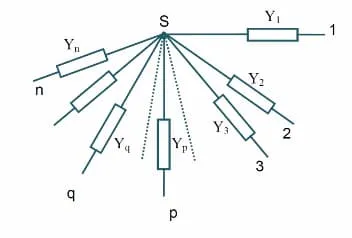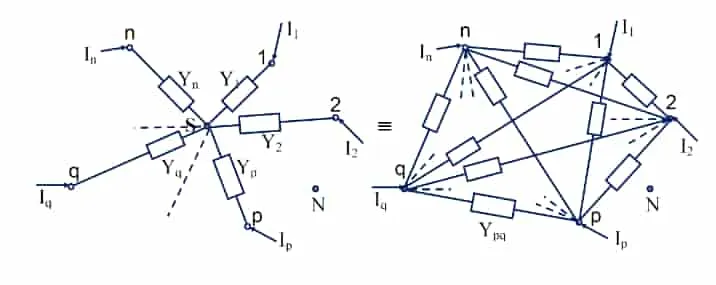Definitions
Section titled “Definitions”Linear network
Section titled “Linear network”A network is linear iff frequency of the output signal is equal to the frequency of the input signal.
Thevenin’s theorem
Section titled “Thevenin’s theorem”Any linear electrical network containing only voltage sources, current sources and resistances can be replaced at terminals A-B by an equivalent combination of a voltage source in a series connection with a resistance .
- the voltage obtained at terminals A-B of the network with the terminals A-B open circuited.
- the resistance that the circuit between A-B terminals would have if all the current and voltage sources are set to to provide 0 currents or voltages.
Norton’s theorem
Section titled “Norton’s theorem”In a network made of linear time-invariant resistances, voltage sources and current sources, at a pair of terminals, it can be replaced by a current source and a resistor connected in parallel.
In AC circuits, this theorem can be applied to reactive elements as well.
- the current flowing between the terminals as the terminals are short circuited
- where is the voltage between the terminals with no load
Superstition theorem
Section titled “Superstition theorem”In a linear network with several independent sources, any voltage or current in the circuit can be found as the algebraic sum of the corresponding values obtained by assuming only one source at a time, with all the other sources turned off.
Reciprocity theorem
Section titled “Reciprocity theorem”In a reciprocal network, if an emf in one branch produces a current in another, then if the emf is moved to the second branch, it will cause the same current in the first branch, where the emf has been replaced by a short circuit.
Compensation theorem
Section titled “Compensation theorem”In a linear, bilateral network, any element can be replaced by a voltage source of magnitude equal to the current passing through the element multiplied by the value of the element.
Bilateral network
Section titled “Bilateral network”A circuit whose characteristics are the same when the direction of current through various elements. In a linear passive bilateral network, an excitation and its response can be interchanged.
Maximum Power Transfer theorem
Section titled “Maximum Power Transfer theorem”Aka. Jacobi’s law. The theorem states how to choose (so as to maximize power transfer) the load resistance, once the source resistance is given. It does not say how to choose the source resistance for a given load resistance. The source resistance that maximizes power transfer from a voltage source is always (the hypothetical ideal voltage source).
In a purely resistive network, the load resistance must be equal to the load resistance.
In an AC network, the load impedance must be equal to the conjugate of the load impedance.
And if the load power factor is fixed, the magnitudes of the load impedance and the source impedance must be equal.
In an AC network, if the load is a resistive load and the source has a complex impedance, the load resistance must be equal to the magnitude value of the source impedance.
Millmann’s theorem
Section titled “Millmann’s theorem”
Suppose there are number of admittances which share a point and the other ends are open.
Equivalent Generator theorem
Section titled “Equivalent Generator theorem”
An extension of Millmann’s theorem. A system of voltage sources operating in parallel may be replaced by a single voltage source in series with an equivalent impedance. This is also Thevenin’s theorem applied to generators in parallel.
Rosen’s theorem
Section titled “Rosen’s theorem”
Used to convert star connected network to mesh equivalent. External conditions will not be affected.
When , the conversion becomes quite simple.
Delta to Star
Section titled “Delta to Star”can be found similarily.
Star to Delta
Section titled “Star to Delta”can be found similarily.